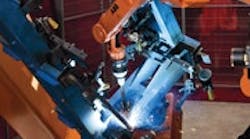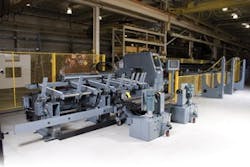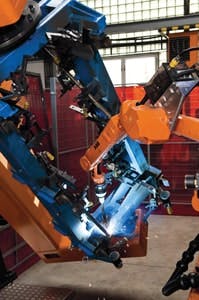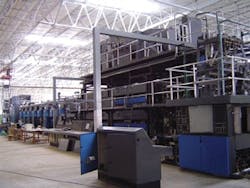That described the state of digital motion buses in 2007, when relatively few motion bus applications existed. Two years later, the landscape has changed dramatically. While there still is confusion on the standards front, the arguments about benefits and costs have crystallized based on application experience.
Wires Everywhere
Few if any automation components have wiring requirements as extensive as a motion controller. From the central controller to the motion controller, discrete signals can include start, stop, reset, table reference pointers and other signals. Analog outputs are typically speed set point and analog type.
From the motion controller to the central controller, discrete signals can include general alarm, alarm codes, executing and position complete. Analog inputs are typically actual speed, torque and other information-based values.
Twenty wires and cables could run between the central and the motion controller. Multiply this wiring by the number of motion controllers within a single machine or robot or material-handling system, and wiring requirements quickly become daunting.
Enter the digital motion bus, which replaces scores of hardwires with one cable—a nice feature for simple systems, but almost a necessity for large and complex machines with many motion controllers.
Wires Be Gone
"Digital buses are an excellent way to communicate between devices in a larger motion control system where hardwiring would result in unneeded complexity or would require more I/O than is feasible," says Jason Woyak, electrical engineer with Advanced Machine Automation in Birmingham, Ala. "The sheer volume of data that can be transferred over a digital bus makes it superior to hardwiring," adds Woyak.
Advanced Machine Automation makes a wide variety of machines including presses, feeders and stackers. It also builds custom machinery ranging from a countertop sawing machine or a fire extinguisher filling station to a gluing machine for truck axles.
One vendor agrees with Woyak about wiring savings and also cites other reasons to go digital. "In systems with many connected devices, multi-drop digital interfaces such as Ethernet offer much lower cost of manufacturing than point-to-point wiring schemes," notes Bill Savela, marketing manager at Delta Computer Systems. "Digital networks have fewer interconnections, and that makes them more reliable since each electrical contact is a potential failure point. When hardware problems do occur, it's much easier to debug and fix systems that are network-based, as compared to those using point-to-point or analog connections."
The maintenance problems solved by motion networks are of particular importance to machine builders. "The reduction in wiring gained by going digital produces a higher MTBF because there are fewer terminations and therefore fewer points of failure," observes Jim Mullins, vice president of engineering at Integrated Motion, a system integrator based in Greensboro, N.C.
Many of the systems designed by Integrated Motion use components from B&R Industrial Automation. Not surprisingly, both integrator and supplier are on the same page when it comes to digital bus benefits. "Replacing hardwired control circuits between machine controller, motion controller and drives with a digital bus greatly reduces the wiring, eliminates potential points of errors and increases noise immunity," says Robert Muehlfellner, director of automation technology at B&R Automation.
Features Abound
When things go wrong with a hardwired system, it can be a real challenge to find the source of the problem. For many, the main benefit of going digital is better diagnostics. "With our digital network, the diagnostics at the operator station are outstanding," exclaims Rick Moscarino, vice president of engineering at Bardons & Oliver in Solon, Ohio.
Setup can be time-consuming, explains Moscarino. "But as our technicians become trained and as they gain experience, this has become less of an issue," he says. "In the case of a field failure, the restarts have been fairly simple, and we typically can support end users via phone."
Joey Stubbs, PE, PMP, North American representative for the EtherCat Technology Group details other diagnostic benefits of digital motion control networks. "With a digital interface, the control system can monitor every internal register at periodic intervals to show temperatures, currents, fault codes, bus voltages, encoder faults and wire breaks. Information such as the manufacturer, firmware revision numbers and serial numbers can be examined to ensure swapped components are exchanged with suitable replacements," says Stubbs.
Another supplier concurs. "With digital networks, drive configuration and maintenance can be managed directly from the main controller," says Robert Hirschinger, marketing manager for Logix Motion at Rockwell Automation. "This helps support catalog number configuration and eases firmware updates for the drive. Extensive drive diagnostics and status information are available at the controller level. OEMs with a large network of drives can more easily monitor, maintain and configure them from a single connection point."
Modern high-performance digital networks deliver features across the board. "Motion buses enable more flexibility for the type of control used in an application, such as the ability to close all loops in the servo amplifier including commutation, torque, velocity and position," notes Bill Faber, senior manager for motion application engineering at Yaskawa Electric America. "An OEM now can use the machine controller to supply trajectories resulting in higher performance because today's servo amplifiers are available with extremely high bandwidths, along with advanced algorithms such as automatic vibration suppression and adaptive tuning."
Distributed Control
For many, the biggest advantage of a digital bus over hardwiring is that it enables distributed control. Distributed control systems can use the motion controller to perform many local control functions, in addition to closed-loop control of motor speed. Functions are implemented through the digital and analog I/O now provided with many motion controllers. These advanced controllers not only have I/O, they also include programming functionality for local real-time control.
It's also often possible to use one high-speed digital network for connectivity among the main controller, motion controllers, other types of remote controllers and remote I/O. This powerful form of distributed control reduces hardwiring to an absolute minimum.
While it's possible to implement distributed control with hardwired connections instead of a digital network, in practice it just doesn't make sense. A distributed control network needs to continually communicate large amounts of data among controllers and I/O. This is accomplished easily via a digital motion bus, but very hard to implement with hardwiring.
Speedline Technologies in Franklin, Mass., makes automated process machines for printed circuit board assembly including solder paste printers, material dispensers, ovens and cleaners. Its stencil printers and dispensers implement distributed control via the CANopen protocol. Each machine has up to 15 axes of motion and 50 I/O. The I/O is primarily digital with a few analog points mixed in. A PC provides supervisory control, and there is an intelligent motion controller at each axis. The 15 or so CANopen-enabled motion controllers handle the local motion control and I/O interfacing. Where needed, a motion controller is provided with additional CANopen I/O modules.
"The intelligent controllers allow us to perform control for real-time intensive tasks at the local level to relieve the burden on the host PC," explains John Klauser, principal electrical engineer at Speedline.
Figure 2: This welding robot features a thin, nimble arm that can combine multiple-axis movements and rotate 360°, ideal for entering narrow spaces and executing complex arc welds. Digital communications simplifies installation of motor controllers at the end of the robot arm.
Source: ABB
Distributed control via a digital network can provide particular advantages in machines with many moving parts, such as a robot. In these instances, the reduced wiring of a digital network means that designers only need to run a single flex cable instead of scores of hardwires.
ABB Robotics makes welding and other robots, many of which use distributed control via digital networks (Figure 2). "With digital communications, we can distribute motor drive units away from the main controller in locations such as inside a robot or on a robot arm," notes Per Carlsson, product manager at ABB Robotics.
Good Things Don't Come Easily
When it comes to raw speed, nothing beats hardwiring, so changing from hardwiring to digital requires particular attention to speed requirements. "Our primary challenge is engineering the bus to stay within required update rates," observes Jeffrey Hanna, manager of control and software development at Intelligrated in Mason, Ohio.
Intelligrated supplies material-handling solutions for warehousing and distribution, postal, parcel and manufacturing environments. It produces machinery for conveying, gapping, palletizing and sorting. Its systems often encompass very large areas, making digital network design particularly challenging.
The company's motion systems use up to 80 servo motors and variable-frequency drives, all connected via Profibus. "Our demands don't include multi-axis coordinated motion, but they do require very tight velocity control, and we frequently need multiple networks to achieve this," continues Hanna. "We engineer a network to have 1 msec, 2 msec or 5 msec update rates depending on the requirements. Profibus-DP has a fixed message format, and the update rates are very predictable and determinant based on the network speed and the number and data size of the nodes. We run the network at speeds from 1.5 to 12 Mbps. Cable length can be a problem with copper, so we use fiber from the controller to the first drop on a network to meet speed requirements."
2. Increased bandwidth
3. Better fit for distributed control
4. Less maintenance required
5. Better noise immunity
6. Better diagnostics
7. Easier software/firmware motion controller updates
8. More precise synchronization
9. More flexible when adding/subtracting controllers
10. Reduced setup time
To reduce jitter, continues Evans, the distributed device has its own high-speed system clock which is synchronized to the controller clock. "The device captures a time stamp when the input is set," he adds. "The device then sends this time stamp over the synchronized digital fieldbus where the controller extrapolates the actual position at the time of the event. This allows an accuracy of less than 1 msec of jitter. This also allows the controller to extrapolate the position of multiple axes, not just one, at the time of the event."
Another network design challenge involves proper cable shielding. "One must use correct cabling and wiring methods to assure that the digital bus is not compromised by electrical noise," notes Mullins of Integrated Motion. "Close attention should be paid to the manufacturer's recommended shielding practices."
Mullins says another big challenge is integrating different motion controllers that don't support a common digital bus protocol. "In such cases a digital bus converter module can be used, but this drives up cost and complexity," adds Mullins.
If there were only one digital network and if all control components had connectivity to that network, integration would be easy, but that's not the case. "Device interoperability is often an issue with motion buses as network implementations can vary," observes Josh Jensen, product line manager at Kollmorgen. "Different networks have different levels of feature validation and device interoperability testing. This can lead to delays and expense as differences might not be evident when selecting two devices that supposedly adhere to the same spec." To solve this problem, Jensen says Kollmorgen maintains a SynqNet Interoperability Lab to continually tests combinations of all devices.
Can Digital Do It All?
In theory, a well-designed digital network doesn't require any supplemental hardwiring, but this isn't always the case in practice. "Most drives hardwire the enable input so the drive can be shut down even if bus communications are interrupted," observes Woyak of Advanced Machine Automation.
|
Although it's possible to implement a separate digital safety bus, this doesn't make sense in all applications. "Although many vendors offer a safety digital bus, some users still prefer a hardwired safety circuit since there is no programming and perhaps lower hardware cost," notes Integrated Motion's Mullins. "The benefit of using a safety digital bus is more prevalent with larger systems and in systems where safe motion functions are demanded by the application."
Adding safety functions to a motion bus often is a question of cost and performance, rather than technical feasibility. "In CANopen and many other motion buses, you can mix safety-related messages with non-safety-related messages if bandwidth is sufficient," says Holger Zeltwanger, managing director for CAN in Automation. "Some system designers might prefer to separate safety- and non-safety-related message by means of two network segments, which can be interconnected by means of gateways or routers."
As digital motion control networks become more widespread, they eventually will incorporate the entire control system and do away with virtually all hardwiring. "Integrated safety functions in drives will eliminate the need for hardwired drive enable signals," foresees Muehlfellner of B&R. "These drives also will provide additional safety functions, such as safe standstill—a condition in which motors can remain under power while a machine is in e-stop, safe stop, safe speed and more. Typical drive I/O, like home and limit switches, as well as master encoders, also will be remotely networked."
To put it more colorfully using an analogy that all can understand, we turn to a machine builder for the last word. "Full network control of safety functions is slowly emerging," believes Speedline's Klauser. "If automobiles can steer and brake by networks, safety can be achieved in machines via similar means."
BRAZIL-BOUND
This printing press with a two-former folder was remanufactured by Quad Graphics GR/T and is currently installed in Sao Paulo, Brazil. The automation system was upgraded and now employs PLC controls, drives and high-speed digital communication networks.
Source: QUAD GRAPHICS
Rebuilt Printing Presses Perform
Quad Graphics in Sussex, Wis., is a commercial printer. Its Graphics Remanufacture and Technologies (GR/T) division supplies automation and other technology advances to its existing printing and custom web presses. Quad has remanufactured more than 18 existing presses, as well as auxiliary equipment for both its press and finishing departments.
GR/T makes extensive use of digital bus communications for motion control. "Our older presses use control platforms based on relays and analog controls linked via hardwiring," says Dave Leitinger, project technical support for GR/T. "The processors and the communications are slow and not real-time-based. Speed, modularity and the amount of data transferred are key in today's market. With Profibus and Profinet, we've been able to bring advanced digital technology to our remanufactured press lines. This allows us to remove old line shafts and slow HMIs and to bring the IT world to the plant floor. We now have the capabilities to modularize auxiliary print equipment and to bring that equipment on-line with the flip of a switch."
Leitinger says digital buses have opened the communication architectures for system controls with more bandwidth, greater scalability, TCP/IP Internet compatibility, safety integration and real-time determinism.
A current project is the remanufacture of an existing press into two separate press lines, each capable of independent in-line finishing production. "We need to shut down one of the two finishing lines with a flip of a switch and run both press lines into a single finishing line," notes Leitinger. "This requires more than 100 Profibus nodes, 14 Profinet drops, 90 axes of motion control and 28 HMIs." All of these components must be provided with safety integration and real-time response, as well.
"Implementing this control system via high-speed digital networks yields lower installation and hardware cost," says Leitinger. "Profinet allows us to meet high-speed demands in real time with cycle times of 250 µsec and almost no variation in delay. The new control system requires less floor space for control cabinets, and the open topology facilitates addition of new components. We now have diagnostic tools with remote access along with data acquisition for production needs."
The new control system eliminates most hardwired safety control. Stop-safe stations, guarding and motor control are now are wired redundantly and locally to Siemens Simatic fail-safe PLCs and to Sinamics drives with safe torque off functionality. "Profinet with Profisafe allows us to pass safety signals over the fieldbus while complying with all safety protocols and standards," concludes Leitinger. "This gives us the advantages of passing safety-related information over the fieldbus, saving additional and costly wiring."
How to Measure Throughput
One of the main challenges in switching from hardwiring to a digital network in a motion-control system is maintaining sufficient speed. Raw specifications only tell part of the tale.
"Network performance is critical to successful implementation of a distributed motion-control network, says Katherine Voss, executive director at the digital network standards organization, ODVA. "However, people often mistakenly use speed on the wire as the prime measure of performance, when in fact there's much more to an effective network than raw data speed."
ODVA argues that total system bandwidth and overall utility of the protocol are at least as important as bit rates, saying throughput is the most effective measure of bandwidth, and it is the best way to measure a network system's overall performance. A good working definition of throughput is the time it takes from detection of an event change (input) to actuation (output) based on logical decision making.
Thus, says ODVA, throughput is a combination of several factors including protocol efficiency (ratio of data to total packet size), network model (information flow paradigm/number and frequency of messages), baud rate (raw bit speed over the wires) and node processing time.
"A distributed-motion-control system is one of the most demanding cases for distributed-control architecture, often requiring extensive configuration, localized intelligence and complex algorithms to achieve the desired machine performance," says Voss.
Some networks, like EtherNet/IP, support services such as I/O messaging to configure axes and file transfer protocols on the same wire with control protocols. A single point of connection and built-in message prioritization allows this architecture to provide machine designers with a distributed system that is easy to maintain.
"The ultimate challenge to a control network is adding or removing work cells as functionality changes," says Voss. "Some networks require substantial programming modifications or rerouting of messages when the mix of work cells changes. Data flow can change, causing interrupt errors and disrupting network efficiency. However, an object-oriented model and logical addressing, such as the common industrial protocol (CIP) used by EtherNet/IP, allows the addition or subtraction of work cells without reconfiguration of other network nodes or communication paths."









